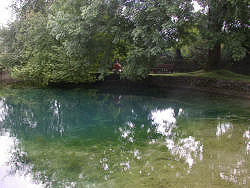Lonetopf
Useful Information
| Location: | Urspring, near Lonsee. |
| Open: |
no restrictions. [2011] |
| Fee: |
free. [2011] |
| Classification: |
 Karst Spring Karst Spring
|
| Light: | n/a |
| Dimension: | A=562 m asl. Yield: A=220 l/s, Min=4 l/s, Max=1.840 l/s. |
| Guided tours: | |
| Photography: | |
| Accessibility: | |
| Bibliography: | |
| Address: | |
| As far as we know this information was accurate when it was published (see years in brackets), but may have changed since then. Please check rates and details directly with the companies in question if you need more recent info. |
|
History
Description

The Lonetopf (Lone spring) is the spring of the small brook Lone, located at the village Urspring, a name which actually means settlement at the spring. The village is first mentioned in 1108 as Urspringam, then again 1255 as Urspringe. This was of course not the first human settlement here at the spring. Since the Palaeolithic man stopped at the spring, but during Roman times the village had great importance. There was a castrum, a Roman military camp, with a vicus, a settlement nearby, located at the Herberg northest of the modern village center. The place was of strategic importance, close to the ascent to the plateau, a station on the Roman road from Mainz to Augsburg and part of the Limes. Archaeologists guess it was the settlement which is named Ad Lunam in documents, because this name is interpreted as at the Lone river. The literal translation would be at the moon.
The karst spring of the Lone is extraordinary, as it is located almost on top of the plateau of the Swabian Jura. But this is a karst plateau with subterranean drainage. The Lone flows in a huge, shallow valley which is cut into the platea, only 50m below the surrounding hills. An those hills to the west actually are the catchment area of the spring. And the course of the river is full of river sinks, so actually the Lone does not reach its confluence with the Brenz most of the year. The valley was formed long ago, when the plateau reach much further to the north. And it was drained at the surface, before the karstification had started. But with the erosion of the plateau the catchment area shrank and the river became too small for its own valley.
- See also
 Search DuckDuckGo for "Lonetopf"
Search DuckDuckGo for "Lonetopf" Google Earth Placemark
Google Earth Placemark Lone - Wikipedia (visited: 10-MAY-2011) (
Lone - Wikipedia (visited: 10-MAY-2011) ( )
) GC1RVPQ Lonetopf - Karstquelle/Karstic Spring (Earthcache) in Baden-Württemberg, Germany created by Asgarin (visited: 10-MAY-2011)
GC1RVPQ Lonetopf - Karstquelle/Karstic Spring (Earthcache) in Baden-Württemberg, Germany created by Asgarin (visited: 10-MAY-2011) Die Schwäbische Alb und ihre Natur: Lonetopf in Lonsee Urspring (visited: 10-MAY-2011) (
Die Schwäbische Alb und ihre Natur: Lonetopf in Lonsee Urspring (visited: 10-MAY-2011) ( )
)
 Index
Index Topics
Topics Hierarchical
Hierarchical Countries
Countries Maps
Maps